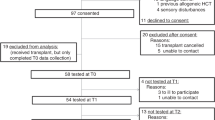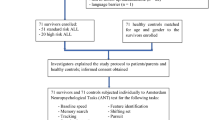Summary:
Patients who undergo bone marrow transplantation (BMT) often report cognitive problems following treatment. This study used cognitive tests and a self-report measure of subjective cognitive complaints to determine (1) the rate of objective cognitive impairment in a sample of 65 BMT patients, and (2) the correspondence of patients' cognitive complaints to their actual cognitive performance. At 6 months following BMT, patients were assessed in seven cognitive domains – attention, verbal learning, verbal memory, visual memory, simple executive function, complex executive function, and psychomotor speed. Cognitive complaints were likewise assessed. In all, 51% had at least mild impairment (−1 standard deviation (s.d.) below published norms) in one or more cognitive domains, with 28% demonstrating moderate-to-severe impairment (−2 s.d.). Older patients and patients with lower IQ were more likely to score in the impaired range on objective cognitive tests, with males and the less educated showing trends toward scores in the impaired range. Younger patients made significantly more cognitive complaints. Total cognitive complaints were unrelated to average cognitive performance, and complaints in specific cognitive domains were largely unrelated to objective performance on corresponding domains. Findings suggest that patients who complain about their cognitive performance following BMT differ from those who experience actual deficits.
This is a preview of subscription content, access via your institution
Access options
Subscribe to this journal
Receive 12 print issues and online access
$259.00 per year
only $21.58 per issue
Buy this article
- Purchase on Springer Link
- Instant access to full article PDF
Prices may be subject to local taxes which are calculated during checkout
Similar content being viewed by others
References
Goldman JM, Horowitz MM . The international bone marrow transplant registry. Int J Hematol 2002; 76: 393–397.
National Bone Marrow Donor Program. Number of Allogeneic Transplants Performed, January 2005. http://www.marrow.org/PHYSICIAN/numberofallogeneictransplants.html.
Saleh US, Brocktopp DY . Quality of life one year following bone marrow transplantation: psychometric evaluation of the quality of life in bone marrow transplant survivors tool. Oncol Nurs Forum 2001; 28: 1457–1464.
Meyers CA, Weitzner M, Byrne K et al. Evaluation of the neurobehavioral functioning of patients before, during, and after bone marrow transplantation. J Clin Oncol 1994; 12: 820–826.
van Dam F, Schagen SB, Muller MJ et al. Impairment of cognitive function in women receiving adjuvant treatment for high-risk breast cancer: high-dose vs standard-dose chemotherapy. J Natl Cancer Inst 1998; 90: 210–218.
Mattis S . Dementia Rating Scale. Professional Manual. Psychological Assessments Resources, Inc: Odessa, FL, 1988.
Schagen SB, Hamburger HL, Muller MJ et al. Neurophysiological evaluation of late effects of adjuvant high-dose chemotherapy on cognitive function. J Neuro Oncol 2001; 51: 159–165.
Harder H, Cornelissen JJ, Van Gool AR et al. Cognitive functioning and quality of life in long-term adult survivors of bone marrow transplantation. Cancer 2002; 95: 183–192.
Syrjala KL, Dikmen S, Langer SL et al. Neuropsychologic changes from before transplantation to 1 year in patients receiving myeloablative allogeneic hematopoietic cell transplant. Blood 2004; 104: 3386–3392.
Radloff LS . The CES-D scale: a self-report depression scale for research in the general population. Appl Psychol Meas 1977; 1: 385–401.
Beeber LS, Shea J, McCorkle R . The Center for Epidemiologic Studies Depression Scale as a measure of depressive symptoms in newly diagnosed patients. J Psychosoc Oncol 1998; 16: 1–20.
Hann DH, Winter K, Jacobsen P . Measurement of depressive symptoms in cancer patients: Evaluation of the Center for Epidemiological Studies' Depression Scale (CES-D). J Psychosom Res 1999; 5: 437–443.
Ware JE, Snow KK, Kosinski M, Gandek B . SF-36 Health Survey Manual and Interpretation Guide. The Health Institute, The New England Medical Center: Boston, MA, 1993.
Ware JE, Kosinski M, Keller SD . SF-36 Physical and Mental Health Summary Scales: A User's Manual. The Health Institute, The New England Medical Center: Boston, MA, 1994.
Hann DM, Jacobsen PB, Azzarello LM et al. Measurement of fatigue in cancer patients: development and validation of the Fatigue Symptom Inventory. Qual Life Res 1998; 7: 301–310.
Hann DM, Denniston MM, Baker F . Measurement of fatigue in cancer patients: further validation of the Fatigue Symptom Inventory. Qual Life Res 2000; 9: 847–854.
Seidenberg M, Haltiner A, Taylor MA et al. Development and validation of a multiple ability self-report questionnaire. J Clin Exp Neuropsychol 1994; 16: 93–104.
Nelson HE . The National Adult Reading Test (NART) Test Manual. NFER-Nelson: Windsor, Berks, UK, 1982.
Crawford JR, Parker DM, Stewart LE et al. Prediction of WAIS IQ with the National Adult Reading Test: cross validation and extension. Br J Clin Psych 1989; 28: 267–273.
Benton AL, Hamsher KdeS . Multilingual Aphasia Examination. AJA Associates: Iowa City, IA, 1989.
Spreen O, Strauss E . A Compendium of Neuropsychological Tests: Second Edition. The Oxford University Press: New York, 1998.
Reitan RM, Wolfson D . The Halstead-Reitan Neuropsychological Test Battery: Theory and Clinical Interpretation. Neuropsychology Press: Tucson, AZ, 1993.
Reitan RM . The validity of the Trail Making Test as an indicator of organic brain damage. Percept Motor Skills 1958; 8: 271–276.
Brandt J . Hopkins Verbal Learning Test: development of a new memory test with six equivalent forms. Clin Neuropsychol 1991; 5: 125–142.
Wechsler D . Wechsler Adult Intelligence Scale: Revised Administration and Scoring Manual. The Psychological Corporation: San Antonio, TX, 1981.
Lezak M . Neuropsychological Assessment, 3rd edn. Oxford University Press: New York, 1995.
Matthews CG, Klove H . Instruction Manual for the Adult Neuropsychology Test Battery. University of Wisconsin Medical School: Madison, WI, 1964.
Wechsler D . Wechsler Memory Scale-III Manual. The Psychological Corporation: San Antonio, TX, 1997.
Trenarry MR, Crosson B, DeBoe J, Leber WR . The Stroop Neuropsychological Screening Test. Psychological Assessment Resources: Lutz, FL, 1989.
Grant DA, Berg EA . A behavioral analysis of degree of impairment and ease of shifting to new responses in a Weigl-type card sorting problem. J Exp Psychol 1948; 39: 404–411.
Heaton RK . Comprehensive Norms for an Expanded Halstead–Reitan Battery: A Supplement for the Wechsler Adult Intelligence Scale – Revised (WAIS-R). Psychological Assessments Resources: Odessa, FL, 1992.
Heaton RK, Grant I, Matthews CG . Comprehensive Norms for an Expanded Halstead–Reitan Battery: Demographic Correction, Research Findings, and Clinical Applications. Psychological Assessments Resources Inc.: Odessa, FL, 1991.
Cull A, Hay C, Love SB et al. What do patients mean when they complain of concentration and memory problems? Br J Cancer 1996; 74: 1674–1679.
Bartynski WS, Grabb BC, Zeigler Z et al. Watershed imaging features and clinical vascular injury in cyclosporin A neurotoxicity. J Computer Assist Tomogr 1997; 21: 872–880.
Shah AK . Cyclosporine: a neurotoxicity among bone marrow transplant recipients. Clin Neuropharmacol 1999; 22: 67–73.
Acknowledgements
This work was supported by the American Cancer Society – Institutional Research Grant entitled ‘Prevalence and Impact of Cognitive Sequelae of BMT’, Margaret Booth-Jones, principal investigator. We are grateful to Christine Marsella and Lori Deitz for editorial support. We thank Karen K Fields, MD, former Program Leader of the Moffitt Cancer Center Blood and Marrow Transplant Program, for her support of psychosocial studies with her patients.
Author information
Authors and Affiliations
Corresponding author
Rights and permissions
About this article
Cite this article
Booth-Jones, M., Jacobsen, P., Ransom, S. et al. Characteristics and correlates of cognitive functioning following bone marrow transplantation. Bone Marrow Transplant 36, 695–702 (2005). https://doi.org/10.1038/sj.bmt.1705108
Received:
Accepted:
Published:
Issue Date:
DOI: https://doi.org/10.1038/sj.bmt.1705108
Keywords
This article is cited by
-
Short-Term Impact of Hematopoietic Stem Cell Transplantation on Depressive Behavior, Cognition and Quality of Life in Leukemia Patients
Indian Journal of Hematology and Blood Transfusion (2024)
-
Patient-reported cognitive function among hematopoietic stem cell transplant and cellular therapy patients: a scoping review
Quality of Life Research (2023)
-
The immediate impact of physical function and quality of life after hematopoietic stem cell transplantation
Supportive Care in Cancer (2022)
-
Cognitive complaints by hematopoietic cell transplantation recipients and change in neuropsychological performance over time
Supportive Care in Cancer (2021)
-
Predictors of the trajectory of cognitive functioning in the first 6 months after allogeneic hematopoietic stem cell transplantation
Bone Marrow Transplantation (2020)



